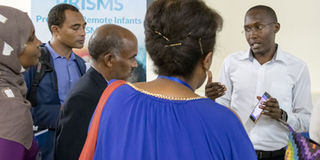Paediatrician in your phone

A man explains a technology idea to delegates at the innovations market place at regional interagency meeting on Neonatal Health for East and Southern Africa Region. Photo by Camila Daza/COURTESY.
What you need to know:
- At first the team designed the app for basic mobile telephones, but the display screen was too small. So they decided to adapt it for smartphones, completing the final version in late 2015.
- The PRISMS team is deploying the app in additional health facilities thanks to a partnership with the Ugandan Baylor Children’s Foundation, and hope to have it running in more than 15 by the end of 2018. They are currently training health workers in how to use the technology in Ntara Health Center IV, Rwamwanja HC III, Kibiito HC IV, Fort Portal Regional Referral Hospital and Rukunyu HC IV.
The sight of midwives rushing about in a small health care unit’s maternity ward, trying to attend to more mothers than they can handle, is a common scene in many hospitals in Uganda. Between the scarcity of much-needed equipment and the shortage in staffing – including doctors – many midwives find themselves having to make quick diagnoses on mothers and newborn babies alone, a daunting task.
Now a group of researchers at Mbarara University of Science and Technology (MUST), Mbarara District, Uganda has developed technology that enables midwives and other health professionals to treat complications of newborns in the absence of a specialist. It’s called Protecting Remote Infants by SMS (PRISMS).
Common problems among newborns include difficulty breathing, high temperatures, bleeding from the umbilical cord or the nose, sepsis, premature birth and jaundice. PRISMS empowers frontline health workers to save newborn lives by providing timely diagnosis and healthcare suggestions through a mobile app. Health workers introduce the newborn’s assessment findings – such as weight, temperature, breathing rate, heartbeat, skin and cord color – into the app, which processes the data and provides care management suggestions by SMS.
Once uploaded into the app, the data is sent to a server and stored securely in a database, where it can be accessed for real-time surveillance, disease monitoring and quality improvement.
For now, PRISMS is only being used for newborns under 28 days of age. The first four weeks of life – the neonatal period – represent the most vulnerable time for a child’s survival, according to WHO. In 2016, 2.6 million deaths, or roughly 46 per cent of all under-five deaths, occurred during this period across the world.
Dr Data Santorino, the leading pediatrician in the group of researchers behind the app, believes this mortality rate is largely preventable. “In environments with limited resources, most newborn healthcare decisions are made mainly by nurses or midwives with no specialized training. We developed PRISMS to mimic a pediatrician,” he says.
Three midwives tested the app for a month in 2016 at the Bwizibwera Health Centre IV, in Kashari Mbarara, Southwestern Uganda. Only one doctor works here, and apart from attending to patients, he has many managerial responsibilities. Up to 100 babies are delivered each month at this facility. About 10 percent suffer from complications and need to be referred to Mbarara Regional Referral Hospital, according to Leonia Nanjovu, one of the midwives who participated in the trial.
“We are lucky to have one doctor. In Health Centre III there is none; there are only midwives, and they do everything. When you are alone you have to manage alone, you don’t have a doctor to consult,” she says. “Even when you have a doctor, he may not be very near. When you have PRISMS, you work on the patient very fast. And medicine is dynamic. This app helps you to know which medicine to give and the proper dosage.”
During the trial, the midwives were able to manage all the newborn complication cases by themselves, without the need to refer the babies to another facility.
“After you have carried out the examination, you feed the results into the app, and within five minutes you get a response on how to manage the case. It directs on how to treat the child; it can also direct you to do more tests,” explains Nanjovu, adding that the app tells you to refer the child if it deems you cannot manage the case alone. Since the trial, the average response time has been improved to less than 10 seconds.
The app was developed starting in 2013 by a multidisciplinary team including Dr Santorino, Nanjovu, software developer Martin Mukama and Dr Francis Bajunirwe, an epidemiologist. It is managed by E-Wall Technologies Company Ltd. The developers had PRISMs registered as an innovation by the newborn steering committee of Uganda’s Ministry of Health.
At first the team designed the app for basic mobile telephones, but the display screen was too small. So they decided to adapt it for smartphones, completing the final version in late 2015.
The PRISMS team is deploying the app in additional health facilities thanks to a partnership with the Ugandan Baylor Children’s Foundation, and hope to have it running in more than 15 by the end of 2018. They are currently training health workers in how to use the technology in Ntara Health Center IV, Rwamwanja HC III, Kibiito HC IV, Fort Portal Regional Referral Hospital and Rukunyu HC IV. “With the little resources we get, we train as many health workers as possible prior to deployment,” says Mukama, noting that instruction is very expensive.




